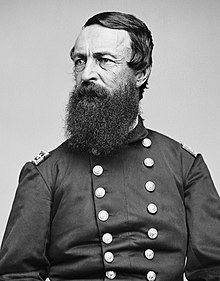
Back ديفيد ديكسون بورتر Arabic David Dixon Porter Danish David Dixon Porter German David Dixon Porter Spanish دیوید دیکسون پورتر Persian David Dixon Porter French David Dixon Porter Hungarian David Dixon Porter Italian デイビッド・ディクソン・ポーター Japanese David Porter (admirał) Polish
David Dixon Porter | |
|---|---|
 Porter in the 1860s, during the American Civil War | |
| Born | June 8, 1813 Chester, Pennsylvania, U.S. |
| Died | February 13, 1891 (aged 77) Washington, D.C., U.S. |
| Buried | |
| Allegiance | |
| Service/ | |
| Years of service | 1825–1828 (Mexico) 1829–1891 (US) |
| Rank | Midshipman (Mexico) |
| Commands held | Superintendent of the U.S. Naval Academy Board of Inspection |
| Battles/wars | |
| Relations | David Porter (father) |
| Other work | Incidents and Anecdotes of the Civil War (1885) |
| Signature | |
David Dixon Porter (June 8, 1813 – February 13, 1891) was a United States Navy admiral and a member of one of the most distinguished families in the history of the U.S. Navy. Promoted as the second U.S. Navy officer ever to attain the rank of admiral, after his adoptive brother David G. Farragut, Porter helped improve the Navy as the Superintendent of the U.S. Naval Academy after significant service in the American Civil War.
Porter began naval service as a midshipman at the age of 10 years under his father, Commodore David Porter, on the frigate USS John Adams. For the remainder of his life, he was associated with the sea. Porter served in the Mexican War in the attack on the fort at the City of Vera Cruz. At the outbreak of the Civil War, he was part of a plan to hold Fort Pickens, near Pensacola, Florida, for the Union; its execution disrupted the effort to relieve the garrison at Fort Sumter, leading to Sumter's fall. Porter commanded an independent flotilla of mortar boats at the capture of New Orleans. Later, he was advanced to the rank of (acting) rear admiral in command of the Mississippi River Squadron, which cooperated with the army under Major General Ulysses S. Grant in the Vicksburg Campaign. After the fall of Vicksburg, he led the naval forces in the difficult Red River Campaign in Louisiana. Late in 1864, Porter was transferred from the interior to the Atlantic coast, where he led the U.S. Navy in the joint assaults on Fort Fisher, the final significant naval action of the war.
Porter worked to raise the standards of the U.S. Navy in the position of Superintendent of the Naval Academy when it was restored to Annapolis. He initiated reforms in the curriculum to increase professionalism. In the early days of President Grant's administration, Porter was de facto Secretary of the Navy. When his adoptive brother David G. Farragut was advanced from rank of vice-admiral to admiral, Porter took his previous position; likewise, when Farragut died, Porter became the second man to hold the newly created rank of admiral. He gathered a corps of like-minded officers devoted to naval reform.
Porter's administration of the Navy Department aroused powerful opposition by some in Congress, who forced the Secretary of the Navy Adolph E. Borie to resign. His replacement, George Robeson, curtailed Porter's power and eased him into semi-retirement.
© MMXXIII Rich X Search. We shall prevail. All rights reserved. Rich X Search